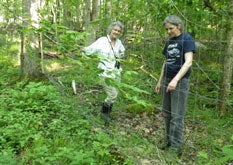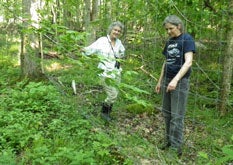 WEST GREENWICH, R.I. – June 17, 2013 – Two half-acre parcels of land fenced to exclude deer at the University of Rhode Island’s W. Alton Jones Campus have demonstrated the dramatic effect that an overpopulation of white-tailed deer is having on native plants and trees.
WEST GREENWICH, R.I. – June 17, 2013 – Two half-acre parcels of land fenced to exclude deer at the University of Rhode Island’s W. Alton Jones Campus have demonstrated the dramatic effect that an overpopulation of white-tailed deer is having on native plants and trees.
Installed in 2011 by the Rhode Island Natural History Survey as part of its Forest Health Works Project, the “deer exclosures” clearly show how deer are reducing the density and diversity of native plants and exacerbating the expansion of invasive species into the forest.
“Deer look for every native plant that they can eat and they eat it,” said Hope Leeson, botanist for the Natural History Survey. “We have continuous still images showing them looking for the proverbial needle in a haystack; heads down, searching for any little tidbit of a native plant they can find. Due to taste or texture, they tend not to eat invasive plants.”
Leeson said that one year after the fences were installed, there was little visible difference in the growth, abundance and diversity of native vegetation inside and outside the fences. But this year the differences are obvious.
Inside the fence, where deer couldn’t gain access, seedlings of oak, sugar maple, hickory and tuliptrees were abundant while outside the fence few could be found. Jack-in-the-pulpit plants inside the fence were knee high while those outside were browsed to stubble by the deer. Inside one of the fences, native trillium planted decades ago by URI botanist Irene Stuckey was once again blooming. None had been seen since 2004.
“Not only has the density of vegetation increased inside the exclosures, but the overall diversity of species has increased as well,” said Leeson. Several new species have been found inside the exclosures, species that were not present when an initial inventory of the site was completed in 2011. “At one site, the height difference among all species was dramatic, with sweet pepperbush two feet high inside the fence and barely visible outside.”
Based on data collected by motion-sensing cameras, the Alton Jones Campus has about 30 deer per square mile. Research in northeastern forests has shown that when deer herds are reduced to about 15 per square mile, native species most susceptible to deer browse, such as trilliums, make a comeback.
“Deer promote the growth of invasive species, which decreases the biodiversity of native vegetation and sets into motion a cascade of effects on the health of the ecosystem,” Leeson said. “Deer aren’t the only factor, and there is a lot we still don’t know, but this study clearly shows there is heavy deer pressure on the plant material in the forest.”
Leeson will present a report of the results of the study later this year to Thomas Mitchell, director of the Alton Jones Campus, who said he will evaluate the results and consider potential options for reducing the deer population.
“We certainly want to have a healthy white-tailed deer population, but it can’t come at the expense of the overall health of the forest. There must be a balance,” said Mitchell.
“I know that deer population reduction efforts are already happening in other parts of the state to reduce the damage from too many deer browsing the vegetation, most notably at the Scituate Reservoir,” he added. “I’m going to carefully consider the data and recommendations from the Natural History Survey and others to formulate a plan to keep the forest healthy.”
Caption: R.I. Natural History Survey botanist Hope Leeson (right) and volunteer Julie Sharpe observe the differences in vegetation inside and outside of a “deer exclosure” at the URI W. Alton Jones Campus. (Photo courtesy of Hope Leeson.)

